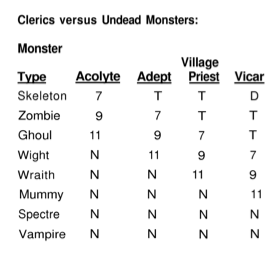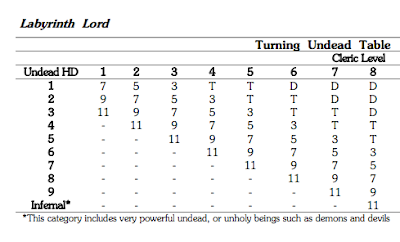 |
| Image from Wikipedia |
For Hexagram, after some consideration, I have decided to preserve the classic six ability scores, with normally distributed (that is, 3d6) ranges, though with decreased direct mechanical weight. The classic scores are easy to understand, provide enough dimensions to make characters seem unique, aid in developing a character’s personality, and provide a convenient resolution mechanic (the roll-under ability check) for many supplementary tasks.
Intelligence and wisdom can sometimes feel like they cover the same space, though. In the first version of the game, intelligence and wisdom were prime requisites (for magic-users and clerics, respectively) and gave a small bonus to earned experience for those classes. The only other effects were bonus languages from intelligence, and some loose roleplaying guidance. Thus, the only thing we can really say about these ability scores at this point is that intelligence has more to do with book learning and wisdom with spiritual connection (to deities, or perhaps the cosmos at large).
Moldvay (and, obviously, AD&D) started to attach more mechanical consequences to ability scores, and this expanded (or perhaps more thoroughly pinned down) their meanings. I’m not really interested in the complexity of AD&D ability scores (especially with the beginning of optimization tendencies associated with racial bonuses, exceptional strength, maximum spell level, minimums required for classes, and all that), so I’m going to stick with Moldvay for discussion purposes. Intelligence and wisdom maintain their experience bonus function as prime requisites, but wisdom also affects saving throws against magic (following the now mostly standardized +1, +2, +3 bonus progression). This already starts to create some extra confusion though. If intelligence is the thing used by magic-users, why is the save versus spells affected by wisdom?
For Hexagram, intelligence is intellect and rationality, while wisdom represents intuition, willpower, and magical acuity. As both spiritual and sorcerous archetypes walk down the path of wonder, wisdom is probably the ability score most associated with wonder workers, and gives a small bonus to saving throws versus magic. Intelligence helps with utilizing antediluvian machines (and more mundane devices, too).
The mental ability scores are further complicated by the player/character split. All tabletop RPGs that I can think of involve some puzzles that the player must solve independently of character abilities. There may be some aspects of the game that you can use mental ability scores on digetically (for example, an intelligence check to recognize the origin of an ancient inscription). This varies by edition and specific gaming group, but even Fourth Edition requires the player to reason about, for example, tactical positioning, which is almost certainly something that an 18 intelligence PC would be better at than the player. This is not a problem; if these things are games, there must be some way for the player to play them.
Further, one or the other scores often do double duty as a perception or situational awareness ability in games that don’t have a separate perception skill. It looks like Fifth Edition is going in this direction. I don’t believe this serves the game well, and in Hexagram ability checks are never used for gathering situational information. All obvious features are communicated directly by the referee. Locating hidden features, however, requires further explicit character action. I call this THE PERCEPTION RULE.
For example, if there is a room with a map concealed beneath a rug, the referee will only describe the rug. If characters do not look under the rug, they will not find the map. Players may also opt to perform an abstract search, at the cost of spending time (this often has potentially deleterious consequences, such as encountering enemy patrols, and so is wise to avoid when possible).
One common modification to the traditional ability score spread and paradigm is to collapse similar ability scores together. For example, to have a single body score in place of strength and constitution, or a single mind score in place of intelligence and wisdom. Microlite goes this route, as does X-plorers and Adventure Fantasy Game. One downside to this approach is that it can make different characters seem very similar to players that look to the numbers for some idea of what makes a given character unique.
Ultimately, many different levels of ability score resolution could work, and none will truly reflect the multifarious aspects of a fully realized person. For example, is it worthwhile to differentiate between bodily agility and manual dexterity? White Wolf games use a nine-fold division into physical (strength, dexterity, stamina); social (charisma, manipulation, appearance); and mental (perception, intelligence, wits). Skills & Powers (D&D 2.5) provides two subscores for each of the classic six: strength (stamina & muscle), dexterity (aim & balance), constitution (health & fitness), intelligence (reason & knowledge), wisdom (intuition & willpower), and charisma (leadership & appearance). Certainly, there exist real people with high intuition but low willpower. For my purposes though, I think the six-fold division strikes a nice balance.
Another common modification is to collapse saving throws and ability scores into a single system. There has always been some level of confusion over what exactly saving throws represent. Is a saving throw versus wands a dodge? If so, why doesn’t dexterity provide a bonus? Further, some early products used the term saving throw in a more general way, and allowed saves versus ability scores. In a game without levels, ability checks as saving throws seems like the way to go, but in a game with advancement, the saving throw has an important separate function, which is to reward successful play. You can’t just make a character with a high save versus poison (like you can potentially with constitution). You have to earn it.
Also, divorcing the saving throw from randomly determined ability scores is important to game fairness: remember that a beginning PC may have a constitution score of anywhere from 3 to 18 (if used as a saving throw, that’s a huge range of variation for surviving a potentially fatal hazard). That entire range should produce a viable and playable character. Saving throws even the playing field in terms of catastrophic risk, while allowing interesting character variation. If the game does not include the possibility of catastrophic risk, this is not a concern, but if it does, the game design of the saving throw is very important. Thus, ability checks cannot be used in place of saving throws. I call this THE SAVING THROW RULE.
One final cosmetic note. The original ability score order was strength, intelligence, wisdom, constitution, dexterity, charisma. The reason for this order is that the first three are the prime requisites, in the order of class importance, fighter being the default and most general class (strength), followed by the magic-user (intelligence), and finally the more specialized blend of the first two, the cleric (wisdom). As I’m not using experience modifiers by prime requisite, and am interpreting all of the ability scores more diegetically, the later physical / mental order is more appropriate (strength, dexterity, constitution, intelligence, wisdom, charisma).
My next post will cover more literally the ability score rules for Hexagram, and how ability checks work.










